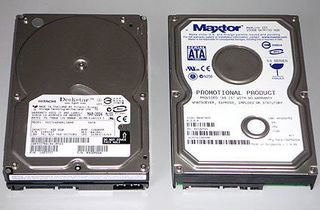Hitachi's 7K400 Hard Drive Capacity Reaches 400 GB, Maxtor's MaXLine III Advances Serial ATA
Innovation, Finally

The past year saw very few changes in the hard drive market, as the maximum capacity barrier of 250 GB (reached in spring 2003) remained unsurpassed until a few weeks ago. At the same time, drives with a Serial ATA interface are hardly more expensive these days than the Ultra-ATA solutions. Also, there is an increasing number of drives supporting command queuing, at last providing Serial ATA with significant added value.
We took a closer look at two drives in our test lab: The Hitachi-made DeskStar 7K400, which features five platters of up to 80 GB each for an impressive storage capacity of 400 GB. This drive is available with UltraATA/100 and SATA150 interfaces.
The Maxtor MaXLine III arrived along with Intel's LGA775 test platform. Two of these drives were included as reference, as they support Command Queuing (matching ICH6) and because they boast a bulky 16 MB memory buffer.
In introducing the MaXLine III, Maxtor debuts its first native Serial ATA controller. Meanwhile, Hitachi is sticking to a bridge solution in its 7K400. Inevitably, such drives are not capable of handling command queuing (known from the SCSI realm), a technology that is capable of processing incoming commands in the most efficient sequence.
Hard Drives: The Basics
To understand how command queuing works, we should take a basic look at how a hard drive actually works. Within the square, gray boxes, we find the actual, round discs. Typically, up to five magnetic storage discs, known as platters, are used. The top and the bottom side are written, each side with a capacity of roughly up to 40 GB these days. Greater storage densities should be available in the fall.
Heads handle the reading and writing. They are held via long, comb-shaped arms above the platters. A servo motor moves them precisely to the desired position or into a secure parking position. After all, one of the gravest dangers for the hard drive is the so-called head crash: As the name suggests, this happens when one of the heads crashes onto the surface.
In principle, the drives are written, track by track, from the outside in, since the absolute speed of the storage disc is greatest on the outside and the data transfer rates are usually best there. When a track is written, the process then moves to the bottom of the platter, and then to the next platter. That minimizes the head movements. As the hours of operation increase, so does fragmentation: If individual data are deleted and a new, larger file is written, then this file could easily be stored in two locations (and that, in turn, leads to additional head movements.)
Stay on the Cutting Edge
Join the experts who read Tom's Hardware for the inside track on enthusiast PC tech news — and have for over 25 years. We'll send breaking news and in-depth reviews of CPUs, GPUs, AI, maker hardware and more straight to your inbox.
Most Popular

